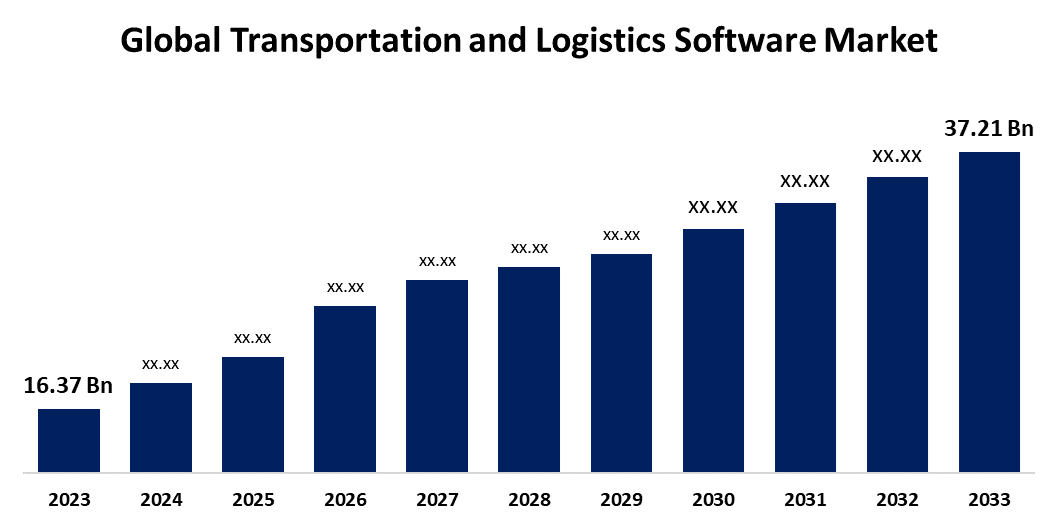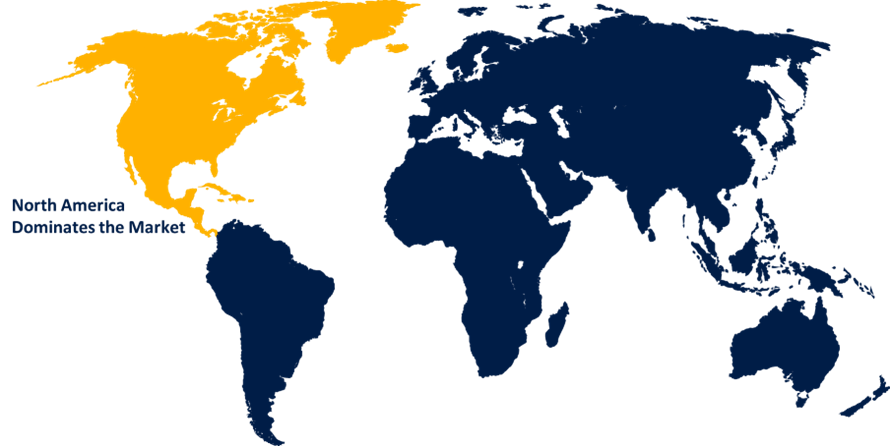Global Transportation and Logistics Software Market Size, Share, and COVID-19 Impact Analysis, By Platform (Windows, Android, IOS, and Others), By Subscription (Monthly, Annually, One Time License, and Others), By Application (Freight Forwarding Companies, Courier Service Providers, Network Service Providers, and Others), and By Region (North America, Europe, Asia-Pacific, Latin America, Middle East, and Africa), Analysis and Forecast 2023 - 2033
Industry: Information & TechnologyGlobal Transportation and Logistics Software Market Insights Forecasts to 2033
- The Global Transportation and Logistics Software Market Size was estimated at USD 16.37 Billion in 2023
- The Market Size is Expected to Grow at a CAGR of around 8.56% from 2023 to 2033
- The Worldwide Transportation and Logistics Software Market Size is Expected to Reach USD 37.21 Billion by 2033
- Asia-Pacific is Expected to Grow the fastest during the forecast period.

Get more details on this report -
The Global Transportation and Logistics Software Market Size is expected to cross USD 37.21 Billion by 2033, growing at a CAGR of 8.56% from 2023 to 2033. The global transportation and logistics software market presents substantial prospects as demand for automation, real-time tracking, and AI-powered logistics management grows. E-commerce, digital freight platforms, and cloud-based solutions are driving adoption, while sustainability measures and smart fleet management offer additional growth opportunities. Emerging markets and improvements in blockchain for supply chain transparency provide up new growth opportunities.
Market Overview
The global transportation and logistics software market is an industry that focuses on digital solutions for optimizing and automating transportation, supply chain, and logistics processes. These software solutions help firms handle fleet operations, route planning, shipment tracking, inventory control, warehouse management, and freight management more efficiently. Transportation and logistics software improves operational efficiency, cost reduction, real-time visibility, and decision-making by incorporating technologies such as artificial intelligence, internet of things, cloud computing, and big data analytics. Furthermore, the global transportation and logistics software market is experiencing developments like AI-powered automation for route optimization, demand forecasting, and predictive maintenance. The use of cloud-based logistics systems is growing, providing real-time data access and scalability. Additionally, IoT and blockchain integration improve supply chain transparency, security, and efficiency.
The increasing digitization of the logistics business has considerably improved operational efficiency. Many businesses are implementing transportation management systems (TMS) and warehouse management systems (WMS) to streamline operations, shorten transit times, and increase visibility into supply chains. The advent of cloud-based solutions has also made these software platforms more accessible to small and medium-sized businesses (SMEs), who want to compete with larger players by upgrading their logistical procedures. Government laws aimed at improving transportation safety, fuel efficiency, and emission control are also driving the adoption of innovative software solutions in this industry.
Report Coverage
This research report categorizes the transportation and logistics software market based on various segments and regions forecasts revenue growth and analyzes trends in each submarket. The report analyses the key growth drivers, opportunities, and challenges influencing the transportation and logistics software market. Recent market developments and competitive strategies such as expansion, type launch, development, partnership, merger, and acquisition have been included to draw the competitive landscape in the market. The report strategically identifies and profiles the key market players and analyses their core competencies in each sub-segment of the transportation and logistics software market.
Global Transportation and Logistics Software Market Report Coverage
| Report Coverage | Details |
|---|---|
| Base Year: | 2023 |
| Market Size in 2023: | USD 16.37 Billion |
| Forecast Period: | 2023 - 2033 |
| Forecast Period CAGR 2023 - 2033 : | 8.56% |
| 2033 Value Projection: | USD 37.21 Billion |
| Historical Data for: | 2019-2022 |
| No. of Pages: | 246 |
| Tables, Charts & Figures: | 116 |
| Segments covered: | By Platform, By Subscription, By Application, By Region and COVID-19 Impact Analysis. |
| Companies covered:: | FarEye, VIP Delivery, LogiNext Mile, Omnitracs Roadnet, Descartes, RouteSmart Technologies, Mettler Toledo, UltraShipTMS, Avaal, Llamasoft, ShipFusion, Ramco Logistics Software, Phalanx, Manhattan, ProTransport, Others |
| Pitfalls & Challenges: | COVID-19 Empact, Challenge, Future, Growth, & Analysis |
Get more details on this report -
Driving Factors
The global transportation and logistics software market is being driven by the growing demand for operational efficiency and cost savings, which is encouraging organizations to adopt automated logistics solutions. Regulatory requirements for fleet management and environmental sustainability are driving businesses to deploy compliance-focused software. The increased demand for real-time data analytics and visibility in transportation networks is driving up software use. Rapid urbanization and increased globalization are boosting the demand for effective logistics management systems. The rise of multi-modal transportation and last-mile delivery services is increasing demand. Furthermore, the surge in cybersecurity concerns has prompted the use of safe, AI-powered logistics solutions.
Restraining Factors
Data security and cybersecurity concerns are important, especially with the growing use of cloud-based and IoT-integrated solutions. The scarcity of experienced individuals to run and maintain complex logistics software can stifle market growth. Infrastructure restrictions in developing nations, as well as varied legislative frameworks across countries, impede seamless adoption.
Market Segmentation
The transportation and logistics software market share is classified into platform, subscription, and application.
- The windows segment held the greatest share in 2023 and is anticipated to grow at a significant CAGR during the forecast period.
Based on the platform, the transportation and logistics software market is divided into windows, android, IOS, and others. Among these, the windows segment held the greatest share in 2023 and is anticipated to grow at a significant CAGR during the forecast period. Many logistics and transportation organizations favor Windows-based solutions because they are scalable, easy to integrate with current ERP and supply chain management systems, and have a robust IT support infrastructure. Furthermore, Windows-based software provides complete capabilities for fleet administration, route optimization, and warehouse operations, making it the favored option for large businesses.
- The annually segment accounted for the majority of the share in 2023 and is estimated to grow at the fastest CAGR during the projected timeframe.
Based on the subscription, the transportation and logistics software market is divided into monthly, annually, one time license, and others. Among these, the annually segment accounted for the majority of the share in 2023 and is estimated to grow at the fastest CAGR during the projected timeframe. Businesses prefer annual subscriptions because of their low cost, long-term stability, and access to ongoing software updates and support. Annual plans also improve financial planning for businesses by eliminating the inconvenience of frequent renewals compared to monthly subscriptions.
- The freight forwarding companies segment held the largest share in 2023 and is estimated to grow at the fastest CAGR during the predicted timeframe.
Based on the application, the transportation and logistics software market is divided into freight forwarding companies, courier service providers, network service providers, and others. Among these, the freight forwarding companies segment held the largest share in 2023 and is estimated to grow at the fastest CAGR during the predicted timeframe. This dominance is being pushed by the globalization of trade, the rise of cross-border e-commerce, and the necessity for effective supply chain management. Freight forwarders use advanced logistics software for real-time tracking, documentation management, route optimization, and compliance management, which improves operational efficiency.
Regional Segment Analysis of the Transportation and Logistics Software Market
- North America (U.S., Canada, Mexico)
- Europe (Germany, France, U.K., Italy, Spain, Rest of Europe)
- Asia-Pacific (China, Japan, India, Rest of APAC)
- South America (Brazil and the Rest of South America)
- The Middle East and Africa (UAE, South Africa, Rest of MEA)
North America is anticipated to hold the largest share of the transportation and logistics software market over the predicted timeframe.

Get more details on this report -
North America is anticipated to hold the largest share of the transportation and logistics software market over the predicted timeframe. This dominance is fueled by widespread adoption of advanced logistics technology, a well-developed transportation infrastructure, and the existence of significant logistics service providers. The region's robust e-commerce growth, combined with increased investments in AI, IoT, and cloud-based logistics solutions, reinforces its market supremacy. Furthermore, tight regulatory compliance and the need for efficient supply chain management drive enterprises to implement innovative logistics software, ensuring North America's industry leadership.
Asia-Pacific is expected to grow at the fastest CAGR growth of the transportation and logistics software market during the forecast period. This is due to the rapid growth of e-commerce, increased trade activity, and the expanding digitalization of supply chain processes. Countries such as China, India, and Japan are experiencing strong demand for logistics automation, owing to rising customer expectations for faster and more efficient deliveries. Government measures fostering smart transportation, infrastructure development, and digital payment solutions help to boost industry growth. Furthermore, the use of cloud-based logistics software, AI-driven route optimization, and IoT-based fleet management is growing, making Asia-Pacific the most dynamic and dynamically expanding area in this market.
Competitive Analysis:
The report offers the appropriate analysis of the key organizations/companies involved within the transportation and logistics software market along with a comparative evaluation primarily based on their type of offering, business overviews, geographic presence, enterprise strategies, segment market share, and SWOT analysis. The report also provides an elaborative analysis focusing on the current news and developments of the companies, which includes type development, innovations, joint ventures, partnerships, mergers & acquisitions, strategic alliances, and others. This allows for the evaluation of the overall competition within the market.
List of Key Companies
- FarEye
- VIP Delivery
- LogiNext Mile
- Omnitracs Roadnet
- Descartes
- RouteSmart Technologies
- Mettler Toledo
- UltraShipTMS
- Avaal
- Llamasoft
- ShipFusion
- Ramco Logistics Software
- Phalanx
- Manhattan
- ProTransport
- Others
Key Target Audience
- Market Players
- Investors
- End-users
- Government Authorities
- Consulting And Research Firm
- Venture capitalists
- Value-Added Resellers (VARs)
Market Segment
This study forecasts revenue at global, regional, and country levels from 2023 to 2033. Spherical Insights has segmented the Transportation and Logistics Software market based on the below-mentioned segments:
Global Transportation and Logistics Software Market, By Platform
- Windows
- Android
- IOS
- Others
Global Transportation and Logistics Software Market, By Subscription
- Monthly
- Annually
- One Time License
- Others
Global Transportation and Logistics Software Market, By Application
- Freight Forwarding Companies
- Courier Service Providers
- Network Service Providers
- Others
Global Transportation and Logistics Software Market, By Regional Analysis
- North America
- US
- Canada
- Mexico
- Europe
- Germany
- UK
- France
- Italy
- Spain
- Russia
- Rest of Europe
- Asia Pacific
- China
- Japan
- India
- South Korea
- Australia
- Rest of Asia Pacific
- South America
- Brazil
- Argentina
- Rest of South America
- Middle East & Africa
- UAE
- Saudi Arabia
- Qatar
- South Africa
- Rest of the Middle East & Africa
Frequently Asked Questions (FAQ)
-
1. What is the CAGR of the transportation and logistics software market over the forecast period?The transportation and logistics software market is projected to expand at a CAGR of 8.56% during the forecast period.
-
2. What is the market size of the transportation and logistics software market?The Global Transportation and Logistics Software Market Size is Expected to Grow from USD 16.37 Billion in 2023 to USD 37.21 Billion by 2033, at a CAGR of 8.56% during the forecast period 2023-2033.
-
3. Which region holds the largest share of the transportation and logistics software market?North America is anticipated to hold the largest share of the transportation and logistics software market over the predicted timeframe.
Need help to buy this report?